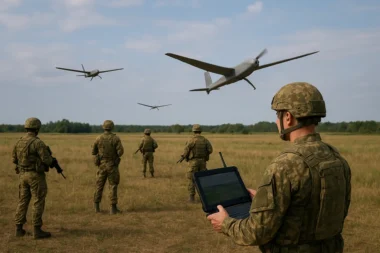The rapid advancement of artificial intelligence (AI) in military technology has led to a new era in aerial combat, one where AI-piloted fighter jets are no longer confined to science fiction. The development and deployment of autonomous aerial combat systems are revolutionizing the landscape of modern warfare. As countries race to harness the power of AI in air combat, the implications for strategy, ethics, and global security are profound.
The Evolution of Autonomous Aerial Combat
AI in military aviation has evolved significantly from early automated systems to sophisticated machine learning-driven piloting capabilities. The journey began with Unmanned Aerial Vehicles (UAVs) and drones, which were initially remote-controlled and later incorporated AI-driven features such as target recognition, autonomous navigation, and real-time decision-making.
A significant milestone occurred in 2020 when an AI algorithm outperformed a seasoned human pilot in a simulated dogfight conducted by the U.S. Defense Advanced Research Projects Agency (DARPA). This event showcased the potential of AI-driven aerial combat, accelerating research into fully autonomous fighter jets. Countries such as the United States, China, and Russia have since been investing heavily in AI-piloted fighter jets, exploring their integration into existing and future combat aircraft fleets.
Capabilities of AI-Piloted Fighter Jets
AI-piloted fighter jets leverage machine learning, deep neural networks, and real-time data processing to execute a range of combat operations. Key capabilities include:
- Autonomous Dogfighting: AI can process vast amounts of data instantly, enabling split-second decision-making in high-speed aerial combat. Unlike human pilots, AI systems do not suffer from fatigue or cognitive overload, allowing for sustained performance in battle.
- Enhanced Situational Awareness: AI-driven systems integrate data from multiple sensors, satellites, and reconnaissance drones to create a comprehensive battlefield picture, enabling superior threat detection and response.
- Swarming Tactics: AI-powered fighter jets can operate in coordinated swarms, executing complex attack maneuvers that overwhelm enemy defenses. This capability reduces risk to human pilots and enhances strategic effectiveness.
- Electronic Warfare and Cybersecurity: AI systems can adapt to cyber threats and electronic warfare tactics, countering enemy jamming, hacking, or spoofing attempts with real-time defenses.
- Autonomous Target Engagement: AI can identify, track, and engage enemy aircraft and ground targets with minimal human intervention, improving precision and operational efficiency.
Software and Hardware Requirements
The effectiveness of AI-piloted fighter jets depends on cutting-edge software and robust hardware components.
Software Requirements
- Machine Learning Algorithms: Advanced deep learning and reinforcement learning models for decision-making and combat strategy.
- Neural Networks: AI-powered perception systems that process real-time sensor data and adapt to changing battle conditions.
- Flight Control Software: Autopilot and adaptive flight control systems enabling seamless maneuvering and combat operations.
- Cybersecurity Protocols: AI-driven cybersecurity measures to detect and neutralize potential hacking threats.
- Sensor Fusion Algorithms: AI-powered data integration from radar, infrared, LiDAR, and satellite systems to enhance situational awareness.
- Simulation and Training Software: Virtual combat environments for training and refining AI combat strategies through reinforcement learning.
Hardware Requirements
- High-Performance Processors: AI chips, such as neuromorphic processors and GPUs, to support complex computations.
- Advanced Radar Systems: AESA (Active Electronically Scanned Array) radar for real-time target detection and tracking.
- LiDAR and Infrared Sensors: Essential for precise object detection and navigation in complex environments.
- Secure Communication Systems: Encrypted data transmission technology for real-time coordination with allied forces and ground control.
- Autonomous Navigation Systems: GPS-independent AI navigation modules for resilience in electronic warfare scenarios.
- Next-Generation Airframes: Lightweight composite materials and adaptive aerodynamics for enhanced agility and fuel efficiency.
Advantages of AI-Piloted Fighter Jets
AI-driven fighter jets offer numerous advantages over traditional piloted aircraft:
- Speed and Efficiency: AI can react faster than human pilots, analyzing threats and executing maneuvers instantaneously.
- Reduced Risk to Human Lives: Autonomous fighter jets eliminate the need for onboard pilots, minimizing casualties in high-risk combat zones.
- Cost-Effectiveness: AI reduces the costs associated with pilot training, salaries, and life support systems, making aerial combat more economically viable.
- Endurance and Persistence: Unlike human pilots, AI does not experience fatigue, allowing for prolonged combat missions without performance degradation.
- Scalability: AI technology enables mass production of autonomous fighter jets without the limitations of pilot availability, offering superior force projection capabilities.
Challenges and Ethical Considerations
Despite their advantages, AI-piloted fighter jets present several challenges and ethical concerns:
- Reliability and Trust: AI decision-making in life or death situations raises questions about reliability, transparency, and accountability.
- Potential for Unintended Consequences: Autonomous weapons could misinterpret data, leading to unintended escalations or friendly-fire incidents.
- Ethical Dilemmas: The removal of human judgment from combat raises moral concerns about AI’s role in deciding to take human lives.
- Cybersecurity Risks: AI systems are vulnerable to hacking and cyber-attacks, which could lead to catastrophic consequences if an enemy takes control.
- International Regulation: The lack of global regulations on AI warfare complicates efforts to ensure responsible deployment and prevent an AI arms race.
The Future of AI in Aerial Combat
The future of AI-piloted fighter jets is likely to involve hybrid models, where AI collaborates with human pilots in “loyal wingman” roles. These AI controlled aircraft will support human piloted jets, providing reconnaissance, electronic warfare capabilities, and additional firepower while maintaining human oversight.
Advancements in quantum computing, neural networks, and swarm intelligence will further enhance AI’s combat effectiveness. Nations will continue to develop strategies to integrate AI into their air forces, balancing technological superiority with ethical considerations and regulatory frameworks.
AI-piloted fighter jets mark a transformative shift in military aviation, offering unprecedented capabilities while raising significant ethical and strategic challenges. As AI continues to redefine aerial combat, the global defense landscape must adapt to ensure responsible development and deployment of these powerful technologies. The rise of autonomous aerial combat is inevitable, how it is managed will shape the future of warfare.



